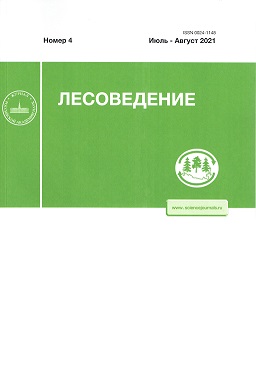RUSSIAN JOURNAL OF FOREST SCIENCE, 2018, No. 4, P. 285-291
LINKAGES BETWEEN STRUCTURE OF ANNUAL RINGS OF SCOTS PINE AND STAND DENSITY IN THE REGION OF CHERNOBYL ACCIDENT
A. A. Belov
All-Russian Research Institute of Silviculture and Mechanization of Forestry
Institutskaya st. 15, Pushkino, Moscow Oblast, 141202, Russia
E-mail: belov@roslesrad.ru
Received 29 September 2016
We studied features of annual rings development in the stands of Bryansk Oblast polluted by radionuclides from Chernobyl accident. The evidence of relationships between zverage annual radial increment, average width of spring and summer layers of timber within an annual ring and stand density was observed in 80-years old blueberry pine forests. We found direct links between annual increment, and its spring and summer components, with average distance between trees. The stand density had the most pronounced effect on the spring growth of timber with the increment gradient from 0.204 to 0.244 mm m-1. While in summer it varied from 0.038 to 0.066 mm m-1. The contribution of the late timber in a tree-ring increased from 50.4-54.8% in the least dense to 72.5-75.8% in the densest stands. However chronic irradiation did not differ across the stand density gradient. Stimulation of the annual growth increment by irradiance was estimated from 50.4 to 51.9%. It contributed from 39.1 to 46.1 of the spring increment to 43.2-58.6% of the summer increment with 95% confidence.
Keywords: Scots pine, stand density, radiocaesium soil pollution, radial increment, tree-ring structure.
DOI: 10.1134/S0024114818040046
REFERENCES
- Antanaitis V.V., Zagreev V.V., Prirost lesa (Forest yield), Moscow: Lesnaya promyshlennost', 1981, 100 p.
- Belov A.A., Potentsial'nye izmeneniya prirosta sosnovykh nasazhdenii v zone avarii na ChAES pod vozdeistviem potepleniya klimata (Potential changes of the annual growth of pine stands in Chernobil disaster zone at the influence of climate warming), Trudy Sankt-Peterburgskogo nauchno-issledovatel'skogo instituta lesnogo khozyaistva, 2013, No. 1, pp. 34-39.
- Belov A.N., Belov A.A., Dinamika sbega radial'nogo prirosta duba v nagornykh dubravakh Povolzh'ya (The dynamics of radial increment in mountial oak forests of the Volga River basin), Lesovedenie, 2007, No. 4, pp. 13-17.
- Belov A.N., Belov A.A., Osobennosti formirovaniya prirosta stvolovoi drevesiny v nagornykh dubravakh Saratovskoi oblasti (Peculiarities of stem wood annual increase formation in the oak groves in the mountains of the Saratov region), Vestnik Moskovskogo gosudarstvennogo universiteta lesa - Lesnoi vestnik, 2006, No. 2 (44), pp. 196-199.
- Bitvinskas T.T., Dendroklimaticheskie issledovaniya (Dendroclimatic studies), Leningrad: Gidrometeoizdat, 1974, 172 p.
- Demakov Y.P., Vozmozhnosti dendrokhronologii v indikatsii i prognoze techeniya prirodnykh i antropogenno obuslovlennykh protsessov (Advances of dendrochronology in indication and prediction of natural and human induced processes), Mathematical and physical methods in ecology and monitoring of environment, Proc. Conf. Moscow, 23-25 October 2001, Moscow: Izd-vo MGUL, 2001, pp. 257-263.
- Ishutkin V.V., Gosudarstvennyi doklad ''O sostoyanii okruzhayushchei prirodnoi sredy Bryanskoi oblasti'' (The State report on the status of environment in Bryansk oblast in 2009), Bryansk: Komitet prirodopol'zovaniya i okhrany okruzhayushchei sredy, litsenzirovaniya otdel'nykh vidov deyatel'nosti Bryanskoi oblasti, 2010, 294 p.
- Lomov V.D., Stroenie godichnykh sloev drevesiny sosny v svyazi s razmeshcheniem derev'ev i sostavom drevostoya (Structure of annual rings of pine timber at various tree locations and specie composition of forest), In: Voprosy lesovedeniya i lesovodstva (Challenges in forest science and silviculture): Izd-vo MLTI, 1985, Vol. 176, pp. 50-53 (101 p.).
- Matveev S.M., Rumyantsev D.E., Dendrokhronologiya (Dendrochronology), Voronezh: Izd-vo VGLTA, 2013, 139 p.
- Moiseev B.N., Strakhov V.V., Raschety vozmozhnoi reaktsii lesov Rossii na global'noe poteplenie klimata (Evaluation of possible feedback of Russian forests to global climate warming), Lesnoe khozyaistvo, 2002, No. 4, pp. 5-8.
- Ovodov A.V., Kachestvo drevesiny sosny v nasazhdeniyakh, sozdannykh posevom i posadkoi: Avtoref. diss. kand. s.-kh. nauk (Timber quality of pine plantations grown from saplings and from seeds. Extended abstract of candidate's agric. sci. thesis), Arkhangelsk: SAFU, 2010, 16 p.
- Prikaz Rosleskhoza N 192, 1994, September 5.
- Rudakov V.E., Metod izucheniya vliyaniya kolebanii klimata na tolshchinu godichnykh kolets (A method of study of climate fluctuations effect on thickness of tree rings), Doklady Akademii nauk Armyanskoi SSR, 1951, Vol. 13, No. 3, pp. 75-79.
- Sanitarnye pravila v lesakh Rossiiskoi Federatsii (Sanitary regulations in forests of the Russian Federation), 1992.
- Slyadnev A.P., Vliyanie biologicheskikh osobennostei sosnovykh nasazhdenii i azotnogo udobreniya na formirovanie godichnykh kolets (The effect of biological features of pine forests and the nitrogen fertilizer on annual ring development), Izvestiya vysshikh uchebnykh zavedenii. Lesnoi zhurnal, 1972, No. 6, pp. 69-74.
- Tyukavina O.N., Izmenenie assimilyatsionnogo apparata, vodnogo rezhima i struktury godichnogo kol'tsa sosny pod vliyaniem osusheniya. Avtoref. diss. kand. s.-kh. nauk (Alterations of assimilation apparatus, water regime and annual ring structure of pines under drainage. Extended abstract of candidate's agric. sci. thesis), Arkhangelsk: AGTU, 2003, 19 p.
- Vaganov E.A., Terskov I.A., Analiz rosta dereva po strukture godichnykh kolets (Growth of a tree: analysis of annual rings structure), Novosibirsk: Nauka, 1977, 94 p.

